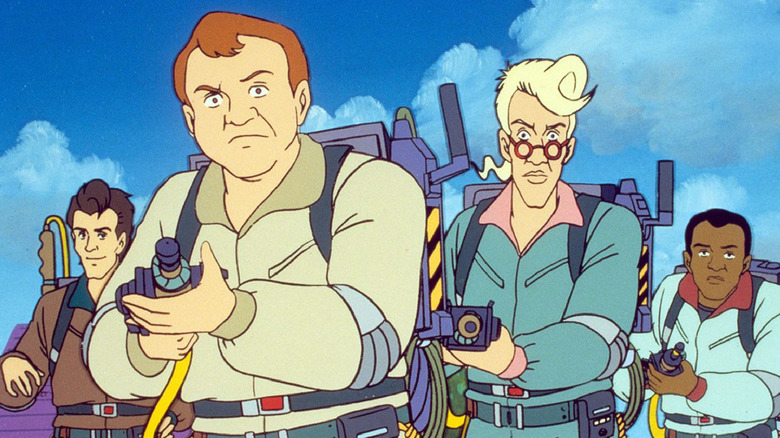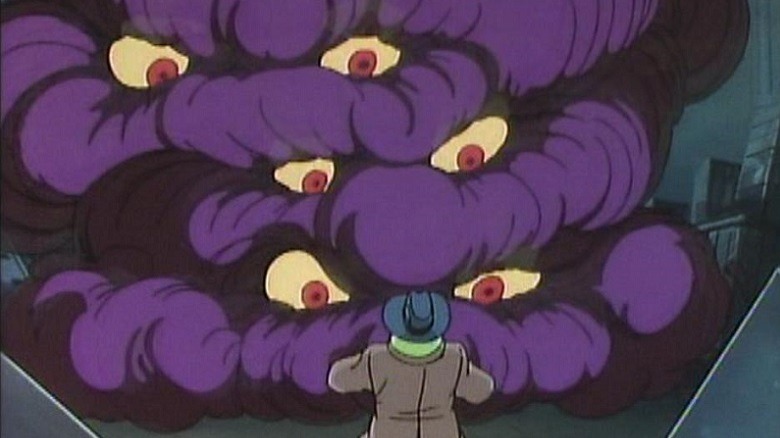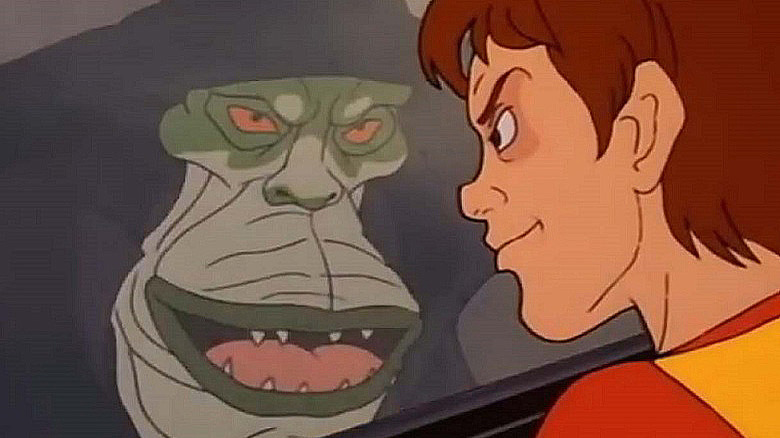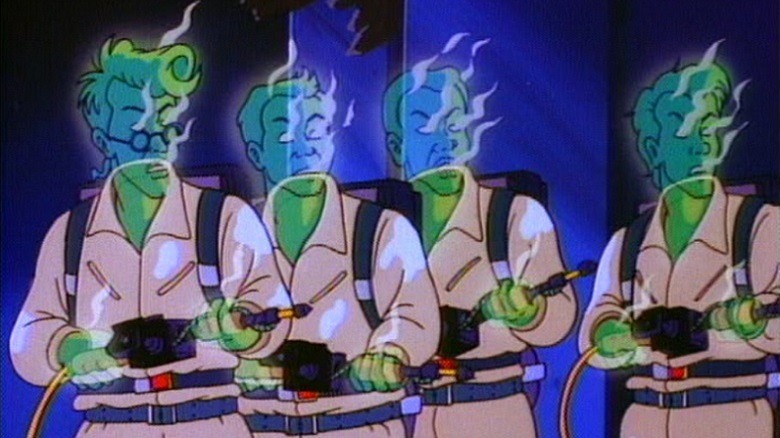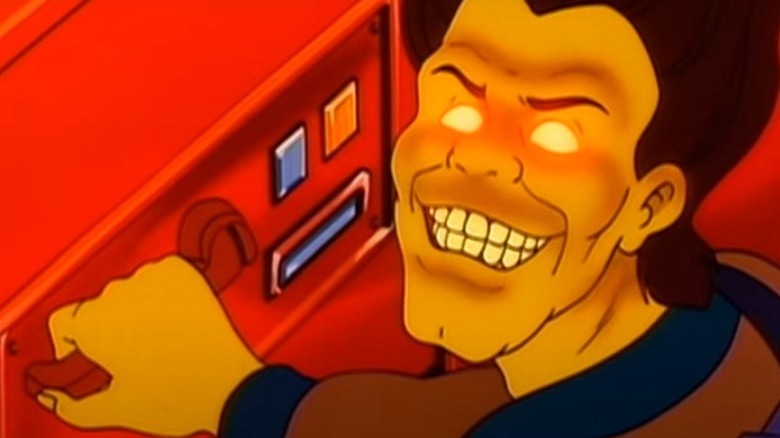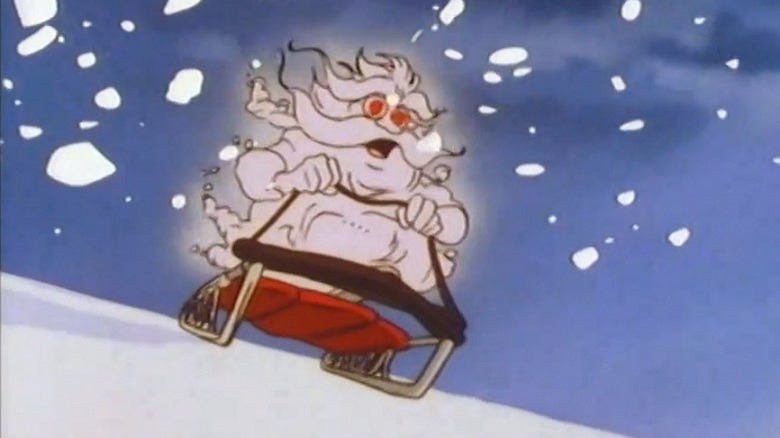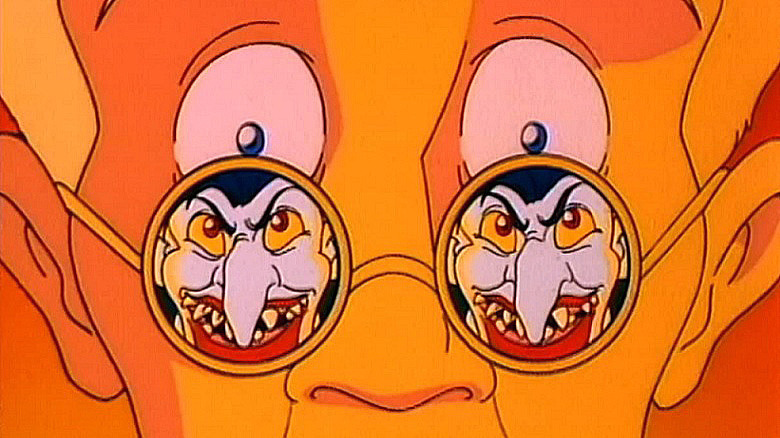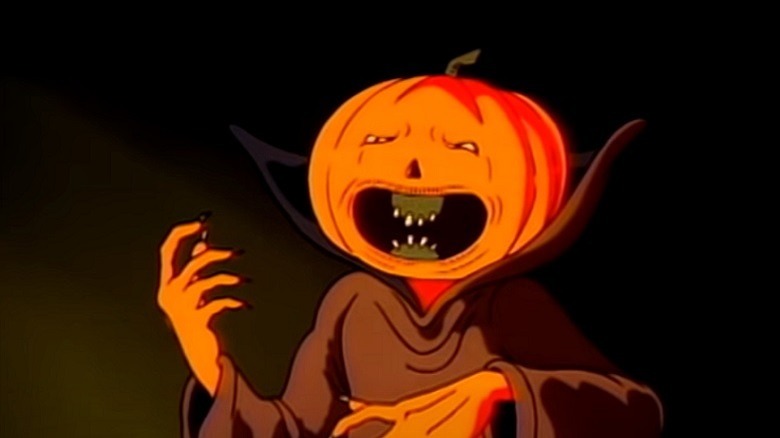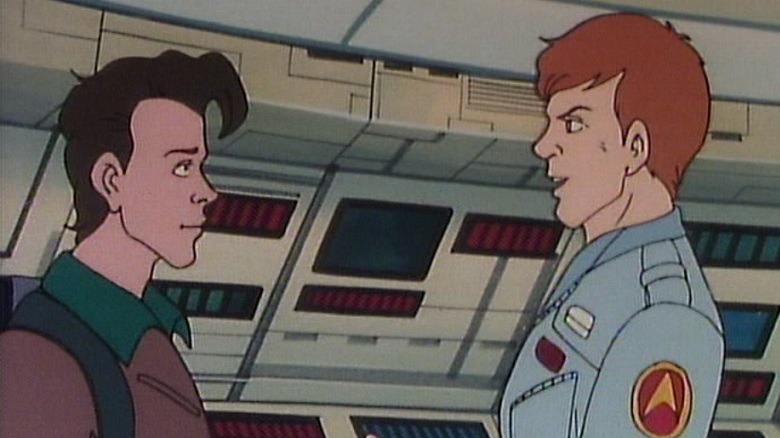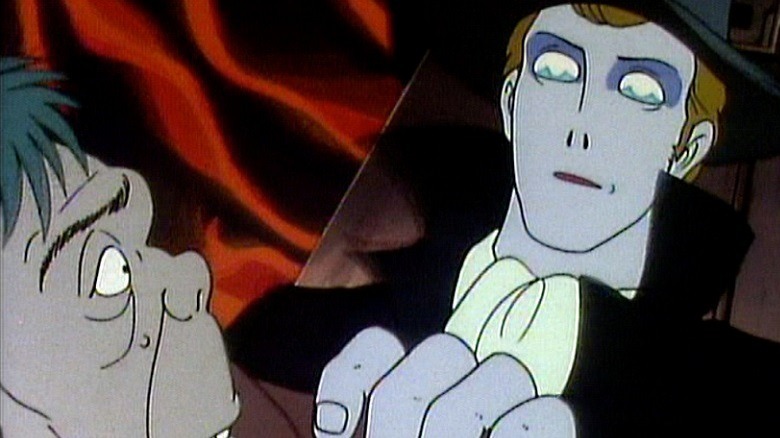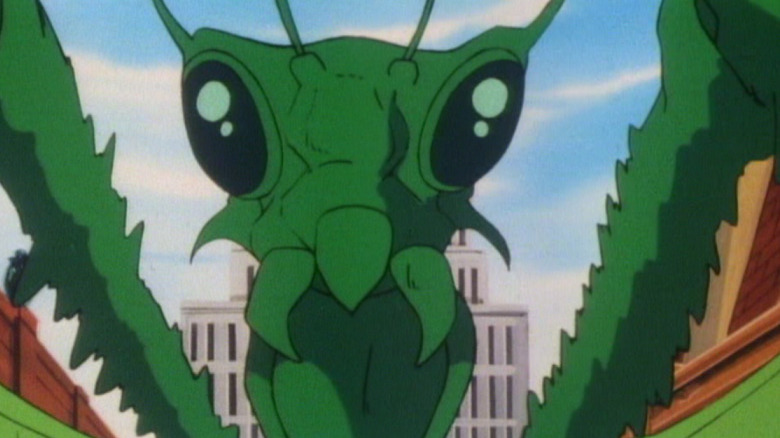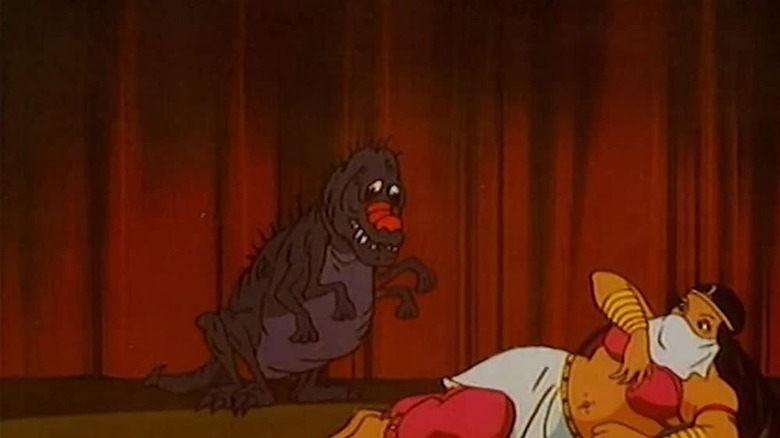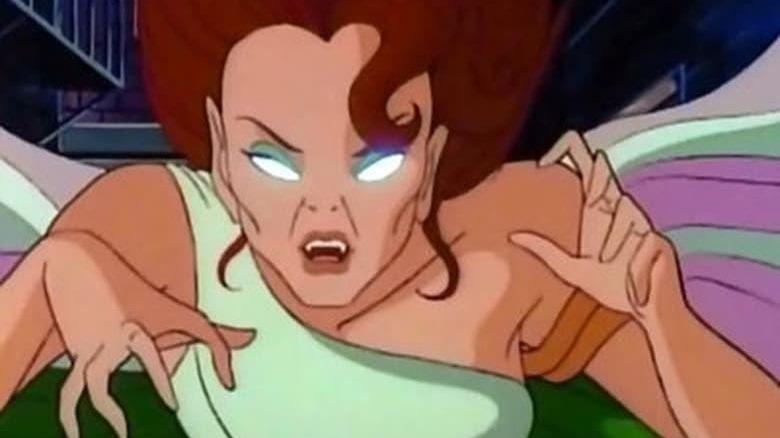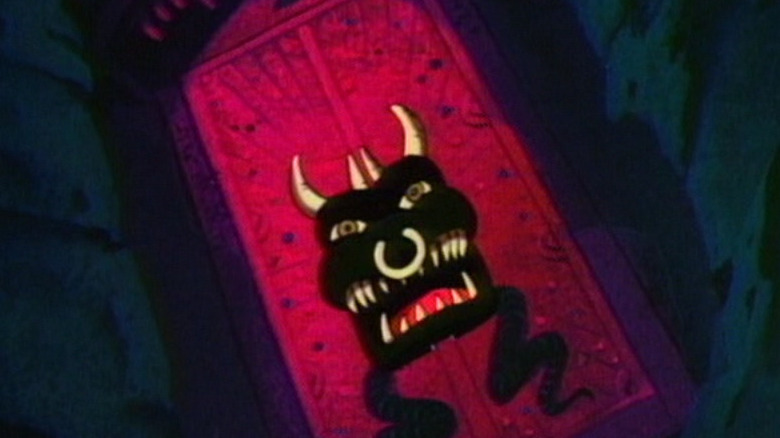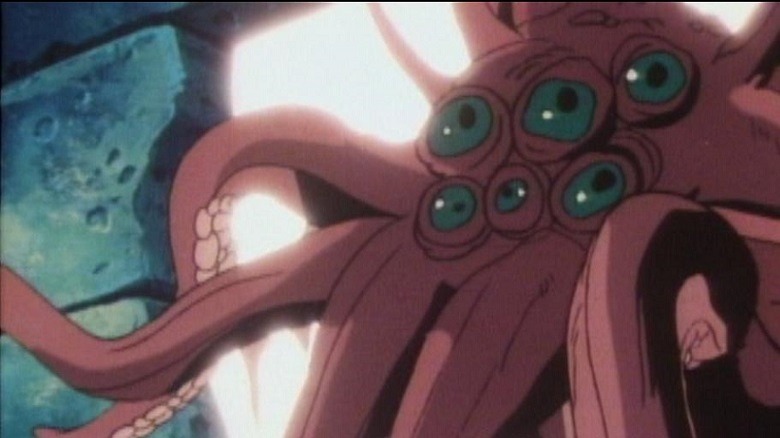The 14 Best The Real Ghostbusters Episodes
The animated series "The Real Ghostbusters" ran from 1986 to 1991, the "Real" prefix added to distinguish it from Filmation's animated series of the same name, which was based on a live-action TV show that aired back in the mid-'70s. A spin-off from the incredibly popular 1984 movie "Ghostbusters," it continued the saga of Egon Spengler, Ray Stantz, Winston Zeddemore, and Peter Venkman (with the cast's appearances all slightly tweaked to avoid any pesky arguments over likeness rights, of course) and became a beloved series in its own right.
Indeed, in an era where a great many cartoons seemed to exist solely to promote a toyline, "The Real Ghostbusters" stood out. Yes, there were plenty of "Real Ghostbusters" toys, too, but the show's quality control prevented the show from ever feeling like an extended commercial (having a pre-"Babylon 5" J. Michael Straczynski on writing and story editing duties surely played a large role in that).
So, strap on your proton pack, flick off the safety on your particle thrower, and let's capture the 15 best episodes of "The Real Ghostbusters" in our containment traps! Just make sure you don't cross the streams -– that would be bad.
The Thing in Mrs. Faversham's Attic
The Peter Venkman of "The Real Ghostbusters" might come across as a sarcastic cynic, but in "The Thing in Mrs. Faversham's Attic," we get to see a rare sentimental side to the derisive doctor.
Taking a job from an old lady who hasn't been inside her attic for 70 years, the team crosses paths with Belleranthon, a gigantic, purple, demonic spirit with a talent for holding grudges and a name that sound like a brand of suppository. You'd be angry, too.
Venkman, in an act of altruism surprising to both the audience and his fellow Ghostbusters, does the job for free because Mrs. Faversham reminded him of his mother — a plot twist as unexpected as Egon's PKE meter overloading due to Belleranthon was predictable.
The Grundel
Another episode featuring pure, high-octane nightmare fuel involves a ghost named the Grundel, an unsettling, red-eyed, green-faced, raspy-voiced fiend who could pass for Rondo Hatton in poor lighting. This loathsome spirit convinces children to be naughty, making them more like him; one particular scene, in which the Grundel hovers outside a boy's window asking to be let in, is very reminiscent of a similar scene from "'Salem's Lot" -– and is equally terrifying.
The versatile Ghostbusters team, clearly as comfortable hunting entities from Lewis Carroll poems as they are trapping ghosts, opens the episode by capturing a Jabberwocky (complete with fetching waistcoat). Later, they encounter Alec, a troubled teen suspected of being under the Grundel's influence. His brother, Lee, knows that something is wrong, and asks for the Ghostbusters' guidance.
Despite ending on a positive note that reinforces one brother's love for the other, the villain alone makes this one of the grimmer episodes of "The Real Ghostbusters," and would not mark the Grundel's final series appearance.
Citizen Ghost
Directly following the events portrayed in the 1984 movie, "Citizen Ghost" sees our victorious heroes returning to their trashed fire station and its ruined containment grid (Thanks a bunch, Walter Peck). After getting rid of their old, ectoplasm-encrusted jumpsuits, Egon and the boys begin the lengthy process of repairing their headquarters.
Over time, it becomes clear that an apparition is living amongst them: Slimer, the globulous green glutton from the Sedgewick Hotel and the first ghost the 'busters ever captured. He's joined by the since-forgotten jumpsuits, which come to life thanks to their ectoplasm coating and seek to rid themselves of their pesky, living equivalents.
Positioned near the end of the show's 1st season, "Citizen Ghost" makes a great "Real Ghostbusters" origin story. Not only does it reveal why these Ghostbusters have color-coded jumpsuits (as opposed to the khaki uniforms of the movies), but also explains why the team would choose to share their home with one of the very creatures they hunt down for a living. All in all, it almost makes "Citizen Ghost" a better sequel to the original film than 1989's "Ghostbusters II" (ducks the impending projectiles of flying ectoplasm).
Mrs. Rogers' Neighborhood
The argument that little old ladies can't be scary is, of course, somewhat dependent on how old they are. 70 years old? Not scary. 700 years old? Probably scary. And when the little old lady in question is, in fact, a mortal disguise for an ancient, class 7 demon? Forget about it.
It's a quiet day when the Ghostbusters are called to sort out a haunted house, and –- despite breaking Egon's PKE meter with an off-the-scale reading -– the little old lady who answers the door doesn't raise any red flags. Suspecting an easy job and a simple invoice, Ray takes Mrs. Rogers and her canary back to Ghostbusters HQ whilst the others investigate. It soon dawns on them that Mrs. Rogers may be more than she appears, and that her house is quite a bit more than a spirit-saturated snare designed to trap the Ghostbusters forever.
It's a simple premise, but a fun one. Puns galore are from a demon named "Wat," and the title conjures up pleasant memories of the lovely, inoffensive "Mister Rogers' Neighborhood" (Rumors that the real Fred Rogers was possessed by an ancient Kandarian demon are, at the time of this writing, unproven).
Ghostbuster of the Year
When Charles Foster Hearse III (publisher of Boosweek and Spooks Illustrated) offers the Ghost Hunter of the Year award to whoever can capture his grandfather's ghost, our intrepid quartet are pitted against one another –- yet the only clue for the haunting is the ghost's mournful cry of "Rosebud."
"The Real Ghostbusters" was always at its best when it aimed to function on multiple levels, and in this case, it delivered a solid story while operating as a pseudo-sequel to one of the most revered films of all time. Barring the (minor) name change, the grandfather is Charles Foster Kane of "Citizen Kane" fame, and -– as anybody with a passing interest in cinema must know by now -– "Rosebud" was his final word before dying.
In addition to voicing Egon, Maurice LaMarche does his very best Orson Welles impersonation as the ghostly grandfather (and would go to voice him again seven years later, in Tim Burton's "Ed Wood"). Also worthy of note in this particular episode: Venkman mentioning Huey Lewis, which seems particularly apt given his unfortunate link to Ghostbusters.
The Boogieman Cometh
"The Boogieman Cometh" begins with the Ghostbusters capturing a ghostly gangster (which, incidentally, reinforces the rule that all cartoon mobsters must sound like James Cagney). Shortly thereafter, a few kids try to hire them with the contents of their piggy bank, claiming there's a boogieman hiding in their closet. Egon seems especially determined to take the case, and we soon find out why: This same legendary monster is directly responsible for Egon getting involved with the supernatural in the first place.
A far cry from the comparatively cuddly Sully and Mike from "Monsters Inc.," this closet-dweller — with his pointed ears, rat-like features, and gargantuan head — is capable of inspiring absolute terror (Indeed, one suspects the Boogieman of causing many nightmares in the wake of this episode's debut). "The Real Ghostbusters" was at its best when creating its own mythology rather than borrowing from the movies, and this recurring villain serves as a perfect example. There's genuine tension and peril here, and when Egon confronts the Boogieman in his own realm (in a scene reminiscent of Billy squaring off against the titular "Predator"), it's easy to forget you're watching a show aimed at children.
When Halloween was Forever
The closer the Ghostbusters get to Halloween, the more difficult their busts become, and Egon suspects that a new museum exhibit (ruins dated to the seventh century) may be to blame. His fears are justified; soon enough, goblins have broken into the museum, releasing a pumpkin-headed creature from an ancient Irish monolith, who then proceeds to wreak Halloween havoc. The streets flood with spirits, apples –- once nonchalant about being bobbed –- begin fighting back, and grotesque statues perched atop churches come to life.
This is Samhain, who –- to the delight of ghosts, dentists, and pumpkin spice latte fans everywhere –- wants to make Halloween last forever. Ancient Irish monoliths haven't caused so much bother since "Halloween III: Season of the Witch."
He's eventually captured, but the episode ends on a chilling note: The other assorted specters within the containment unit are constantly agitated and seeking escape, whereas Samhain, already used to being trapped in a rock, waits there, patiently biding his time. This "Ghost of Halloween" would become a regular villain across the "Ghostbusters" franchise, appearing again in "The Real Ghostbusters" and also featuring in the "Extreme Ghostbusters" spin-off.
Ain't NASA-sarily so
A suspected ghost collides with Space Platform Galileo (no relation to the USS Enterprise shuttlecraft, and any resemblance to Starfleet insignia is entirely coincidental) and the Ghostbusters are sent to investigate. They meet the multinational crew: a captain who throws in random Russian words as exclamations ("Rachmaninoff!," "Dostoyevsky!"), a paler-skinned Uhura, and a Scottish engineer who has to physically restrain himself from reminding the crew "he cannae change the laws of physics."
The Ghostbusters are excited (most of the team's just excited to be in space, while Venkman's thrilled by the prospect of a big, meaty, government contract) until they meet the ghost in question: A red, undulating, amorphous heap of eyes and mouths, it looks like it would be more at home terrorizing an Antarctic research station than a space platform. This ghost -– definitely not an alien, the plot is at pains to point out –- feeds from the proton energy in their packs, and any attack only strengthens it.
Are our heroes doomed to die in space? Of course not; Sony would never have jeopardized their huge franchise. But it is fun seeing our heroes in another environment confronted with an interesting and novel villain.
Ragnarok and Roll
Jeremy and Dytyllio, his Igor-esque hunchback companion, arrive at a hidden shrine in the mountains. This broken-hearted mystic, whose marriage proposal to his beloved Cindy has been rejected, decides to bring about Ragnarok (the literal end of the world) with a magic flute, which is more than a tiny bit selfish.
In New York, our exhausted Ghostbusters battle against waves of winged black fiends that seem immune to their proton shots. As Jeremy and his diminutive deputy arrive back in New York to oversee the final stages of the end of the world -– which is now tormented by earthquakes, volcanoes, and floods -– Egon fears for the worst.
There's a genuine sense of jeopardy here, with a threat of such intensity rarely seen in the series. At one point the despondent quartet realizes the only way to save the day might be to overload their proton packs, sacrificing themselves to save the world, but it's our team's mutual friendship, and Egon's last words being "Janine," that really strike a chord in the end. Dytillio makes for an interesting figure, still loving the world despite how cruelly it's treated him, and it's that level of characterization that makes this episode stand out from the crowd.
The Revenge of Murray the Mantis
There's a rare moment of downtime for our busy 'busters. Egon and Ray are building an airlock for the containment grid (to establish diplomatic relations with the ghosts), while Ray and Winston are washing Ecto-1 in an effort to get it ready for the New York Thanksgiving Day parade. When a parade float — a giant balloon of beloved TV cartoon character Murray the Mantis –- breaks lose, headstrong Peter thinks he's helping by shooting it down. Little does he suspect that the iniquitous inflatable is infused with dead energy, and the blasts from his proton pack bring the creature to life.
Confronted with such a huge foe, the Ghostbusters are left with no option other than to fight fire with fire –- or ectoplasmic, carnivorous insects with anthropomorphized chewy-sugary gelatin, at least. That's right, the Stay-Puft Marshmallow Man is released from containment. It is, quite frankly, a huge relief that they'd have the new airlock built just in time to make this whole concept achievable.
If you were ever desperate to see the Ghostbusters fight kaiju, here's your opportunity. It's great to see such an iconic character return to the screen (and Venkman back to his womanizing ways), but I wouldn't want to be the Ghostbuster responsible for trying to talk the Stay-Puft Marshmallow Man to voluntarily go back into containment.
Drool, the Dog-Faced Goblin
The Ghostbusters take a rare road trip out of the city, journeying to a remote travelling sideshow where Egon's interest gets piqued by a sign advertising a dog-faced goblin. They encounter the creature on stage, but the owner of the sideshow, Madame La Farge, insists that Drool is harmless, just a pet. Prevented from proton-packing it into purgatory, our team try to return home ... but a flat tire on Ecto-1 forces them to take refuge in a nearby hotel.
Encountering a shape-shifting antagonist during their stay, they suspect that it's Drool, but upon returning to the fair they discover that there is more than one creature capable of shape-shifting, and that they have made an ally in the unlikeliest of places.
Other than Slimer and a few occasional exceptions, ghosts and monsters are rarely portrayed sympathetically on "The Real Ghostbusters." "Drool, the Dog-Faced Goblin" deviates from this norm, presenting an affable, kind goblin –- far from the selfish, cunning, mischievous creatures in the series to date — and the episode ends in a way that's both heartbreaking and poignant.
Janine, You've Changed
Eagle-eyed readers may have spotted that, from this list, almost every episode is from the show's first two seasons. There's good reason for that, as a consultancy firm called Q5 were brought in during season 3 to shake things up. This led to Venkman's voice duties moving from Lorenzo Music to Dave Coulier, and Janine being rewritten to soften her up and make her more maternal, a change that saw story editor J. Michael Straczynski leave the show. In earlier episodes, she was a stronger personality, a worthy foil for the four male leads, but later episodes softened her, lessening her as a character.
"Janine, You've Changed" is a rare exception of that rule, a season 6 episode that's half-decent, seeing the brief return of Straczynski for an episode as meta as they came. The Ghostbusters, looking through an old photograph album of receptionist Janine Melnitz, suspect that something is awry: Her appearance has changed dramatically since they've known her, and her Brooklyn accent has vanished completely.
It's brilliant that the series could eventually acknowledge and justify the weird changes in continuity, and that Janine could star in an episode. If only they'd produced an episode that establishes why Venkman went from sounding vaguely like Bill Murray to sounding like he was on the verge of falling asleep.
Knock, Knock
Were you to be put in charge of guarding a door that holds back ancient spirits, preventing them from being released upon the end of the world, I'd recommend implementing a stronger security system than just an imposing voice repeating "Don't open until Doomsday." I would, in fact, recommend a padlock. If nothing else, that'd likely prevent some curious subway workers from stumbling upon it and then trying to open it, which, in turn, would save our intrepid ensemble of ghostbusters a whole heap of trouble.
"Knock, Knock" is an interesting one. It doesn't have the strongest plot and the resolution is a little unclear, but it does have some wonderful character moments. Every one of the Ghostbusters gets a moment to shine here, and the episode contains a number of striking visuals (some of the designs of the monsters running amok within the New York subway are outstanding, perfect examples of classic "Ghostbusters" creature design). I'm also fond of the idea that the door is never properly defeated –- it remains, to be opened during some future Doomsday event, and not a moment before. Sumerians: If you can't get a decent lock for the door, perhaps rest a heavy rock in front of it.
The Collect Call of Cathulhu
Like the episode of "The Waltons" with the poltergeist, "The Collect Call of Cathulhu" is one of those episodes where you might be tempted to wonder, "Did I imagine that?" upon thinking back on it later.
How do you get bigger than Gozer, the Sumerian god of destruction? You pit the Ghostbusters against Big Bad Cthulhu (here named "Cathulhu"), that's how. In the same way that the concept of fighting the forces of Hell with a shotgun in the videogame series "Doom" seemed vaguely silly but simultaneously amazing, so did confronting the High Priest of the Great Old Ones with four unlicensed particle accelerators operated by blue-collar New Yorkers.
Here in 2021, the Cthulhu mythos has wrapped its tentacles around every aspect of popular culture, but it was relatively rare back then: the Necronomicon, Arkham, Miskatonic University — they're all in here, operating as a sort-of H.P. Lovecraft greatest hits collection. Cathulhu is repelled, but not defeated (presumably to keep the literary fans happy) and the episode offers a brilliant example of how to piggyback off another writer's mythology with just enough respect to make the whole thing feel like a heartfelt tribute.
